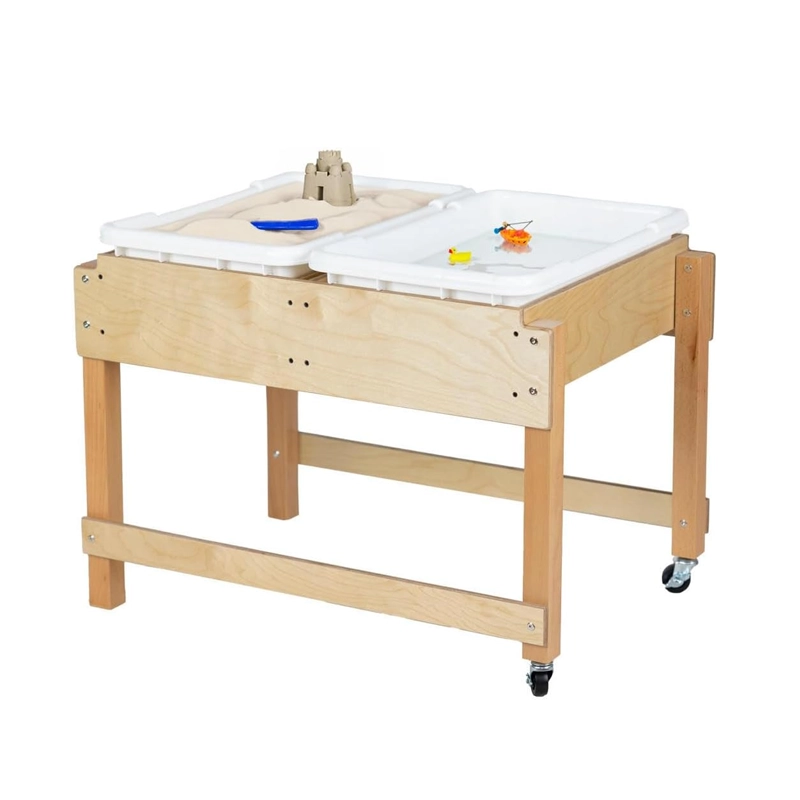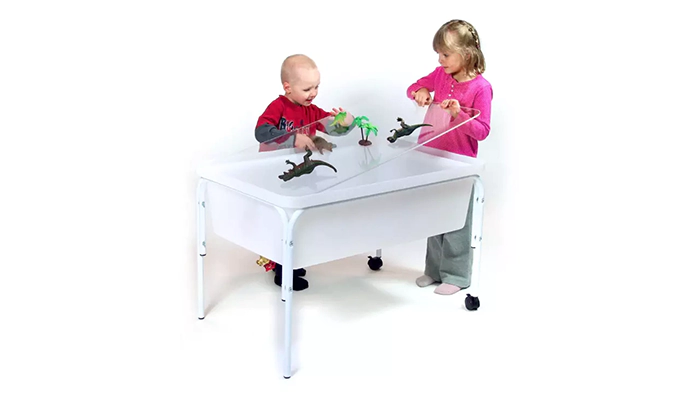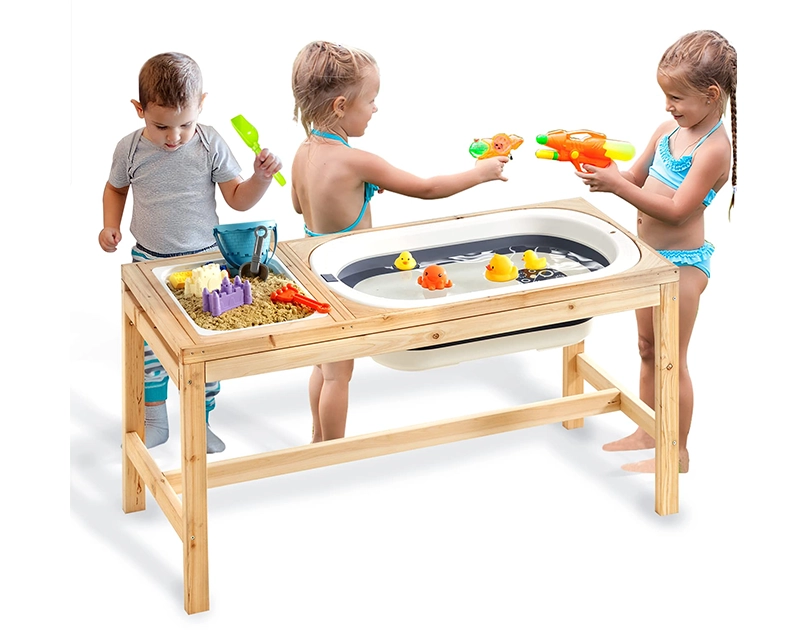
幼児教室のための砂と水のテーブル
当社の砂と水のテーブルは、体験型の感覚的な遊びで幼い心を刺激するように設計されています。教室や保育園、幼稚園に最適なこのテーブルは、安全で管理された環境で、子どもたちが砂や水を探索することができます。耐久性と安全性に優れた当社のテーブルは、高品質の素材を使用しており、忙しい教育関係者でも簡単にメンテナンスができます。
多彩な砂と水のテーブル・コレクション
コンパクトな1段ビンタイプから大型の多機能テーブルまで、イケアのコレクションは、あらゆる年齢のお子さまに安全で魅力的な感覚遊びを提供できるように作られています。小さなスペース用のコンパクトなオプションから、インタラクティブな遊びのための大きな多機能テーブルまで、私たちは完璧なソリューションを持っています。私たちのコレクションをご覧になって、幼稚園や保育施設に最適な砂と水のテーブルを見つけてください。

子供用屋外木製砂場

砂と水のアクティビティテーブル(傘付き

屋外用砂場

海賊船の木製砂場

木製キッズ感覚テーブル

可動式砂と水のプレイテーブル

川床水遊びセット

ラッシング・リバー・フォールズ感覚台
幼児用家具の信頼できるメーカー
ウイニング・キッズは、20年以上にわたる教育用品業界での経験を生かし、比類ない専門知識を提供しています。長年にわたる卓越性へのコミットメントにより、世界中の教育環境の多様なニーズを満たす、信頼性の高い高品質な製品を提供しています。私たちは進化と適応を続け、お届けする各製品が子どもたちの学習体験を高めることをお約束します。
当社の砂と水のテーブルは、最高の品質と安全基準を念頭に置いて設計されています。耐久性に優れ、お子様に優しい製品を製造することを約束するメーカーとして、私たちは、忙しい教室での試練に耐える無害で頑丈な素材を使用することを優先しています。各テーブルは、創造性、運動能力、感覚の探求を育むように作られており、総合的な学習環境を確実にサポートします。カスタマイズ可能なデザインと革新的な機能で、当社の製品はどんな幼稚園や保育園のセットアップにもシームレスに統合され、遊びと教育を向上させます。
お客様にはそれぞれ独自のニーズがあることを理解し、お客様のご要望に合わせたサービスを提供しています。製品のカスタマイズやオーダーメイドのデリバリーソリューションなど、私たちはお客様のご経験がシームレスでご満足いただけるものであることをお約束します。さらに、生産工程全体を通して環境に優しい慣行を取り入れることで、持続可能性へのコミットメントを信じ、高品質の教育製品を提供しながら、より環境に優しく、より責任ある未来に貢献することをお約束します。
砂場と水場で使用される一般的な材料
砂遊びテーブルと水遊びテーブルを選ぶ際、素材は耐久性、安全性、そして全体的な美しさに大きく影響します。適切な素材を選ぶことで、屋外砂遊びテーブルと水遊びテーブルの寿命が長くなり、メンテナンスが容易になり、お子様にとって快適な遊び環境が確保されます。
木材
- 耐久性と自然さ: 木材は、砂遊びや水遊びのテーブルに最も伝統的かつ丈夫な素材の一つです。木製の砂遊びや水遊びのテーブルは、教室や屋外の遊び場に自然な美しさをもたらします。
- 長所: カスタマイズが簡単で、見た目も魅力的、環境に優しい。
- 短所: メンテナンス(水による損傷を防ぐためのシーリングなど)が必要であり、重量が増す可能性があります。
プラスチック
- 軽量で多用途: プラスチックも人気の素材で、特に子供用の小型で持ち運び可能な砂遊びや水遊びのテーブルによく使われています。お手入れが簡単で耐久性に優れているため、理想的な素材です。
- 長所: お手入れが簡単で、手頃な価格で、カビにも強いです。
- 短所: 環境に優しくなく、紫外線に長期間さらされると脆くなる可能性があります。
グラスファイバー
- 耐久性があり長持ちします: グラスファイバーは、屋外の砂場や水場のテーブルによく使用される、強度と耐候性に優れた素材です。
- 長所: 非常に耐久性があり、軽量で、メンテナンスもほとんど必要ありません。
- 短所: 高価であり、木材と同じ自然な美しさを持たない可能性があります。
金属(スチールまたはアルミニウム)
- 頑丈で丈夫: 業務用の砂場や水場のテーブルには、金属フレームで作られているものがあり、通常はステンレス鋼またはアルミニウムのベースが付いています。
- 長所: 非常に頑丈で、錆びにくく、モダンな美しさを備えています。
- 短所: 重くなる場合があり、適切に処理しないと腐食を防ぐために特別な注意が必要になることがあります。
ゴム
- 柔軟かつ安全: ゴムは、砂場や水遊び場の特定の部分、特に成形された縁や柔らかい遊び場によく使用されます。
- 長所: ソフトな手触り、無毒、耐衝撃性。
- 短所: 長期的には他の素材ほど耐久性がない可能性があります。
アクリルまたはプレキシガラス
- クリアで洗練されたデザイン: アクリルは、水と砂の感覚テーブルで使用される透明な素材で、水と砂の可視性を提供し、視覚的に魅力的な遊び体験を生み出します。
- 長所: クリアな視界、スタイリッシュ、耐久性。
- 短所: 傷がつきやすく、プラスチックより高価です。

砂と水のテーブルとは何ですか?
サンド&ウォーターテーブルは、子どもたちが砂や水、その他の感覚刺激となる素材を使って、自由に遊び、探求できるインタラクティブな遊び台です。通常は耐久性のあるプラスチックや木材で作られており、砂や水を入れるための仕切りやトレイが備わっており、子どもたちに実践的な学習と創造性を育む機会を提供します。屋外での遊びに最適で、子どもたちが材料をすくったり、注いだり、混ぜたりすることで、感覚の発達、細かい運動能力、想像力を育みます。サンド&ウォーターテーブルには、遊びをさらに豊かにするために、スコップ、漏斗、型などの付属品が付いていることが多いです。
幼児向け砂遊びと水遊びのメリット
砂遊びテーブルと水遊びテーブルは、幼児の発達に欠かせないツールであり、幼児の感覚、認知能力、運動能力を刺激する様々なメリットをもたらします。これらのインタラクティブな砂遊びテーブルは、安全で管理された環境の中で、創造的な探求と学習の無限の機会を提供します。
感覚の発達
幼児は砂や水で遊ぶ際に、様々な感覚を刺激します。水や砂の質感、温度、性質の違いは、脳の発達に不可欠な感覚探索を促します。
科学探査
これらの表は、水で遊ぶときに、原因と結果、浮力、さらには簡単な天気の概念など、基本的な科学的概念を自然に学ぶことができます。
微細運動能力と粗大運動能力
材料をすくったり、注いだり、扱ったりする行為は、微細運動能力を高めます。一方、掘ったり、押したりする活動は、粗大運動能力の発達を促します。
社会的および感情的なスキル
グループで遊ぶことは、幼児が物を分け合ったり、順番を守ったりといった社会性を身につけるのに役立ちます。また、触覚的な遊びを通して感情をコントロールすることを学ぶため、感情のコントロールも促されます。
問題解決と創造性
子どもたちは水の流れ、砂の構造、そして素材を実験することで、問題解決能力を発達させ、批判的思考力を学びます。これは創造性と認知的柔軟性を育みます。
早期STEM学習
砂場と水場は、子どもたちが科学、工学、数学の基礎概念を学ぶのに役立ちます。水の流れ方、砂の形、そして砂と水の相互作用を観察できます。子どもたちは、体積、因果関係、変位など、将来のSTEM学習に重要な概念を学ぶことができます。
効果的な砂場と水遊び場の重要な要素
砂遊びと水遊びで楽しく、かつ教育的な遊び場を作るには、綿密な計画が必要です。幼児がこれらのインタラクティブな空間を最大限に活用できるようにするには、いくつかの重要な要素を考慮する必要があります。
安全機能
安全はあらゆる遊び場において最優先事項です。お子様用の砂場や水遊び用のテーブルは、角が丸く、無毒の素材を使用し、転倒防止のためしっかりとした安定した土台で作られていることを確認してください。砂には鋭利なものや汚染物質が混入していないことを確認してください。すべての子供が利用可能
ウォーターテーブルと砂場は、身体に障害のあるお子様でも利用できるように設計されていることを確認してください。お子様用の砂場とウォーターテーブルは、車椅子利用者や移動に制限のあるお子様向けに、低いタイプも含め、様々な高さに設置する必要があります。高さ調節可能なデザインは柔軟性を高め、すべてのお子様が快適に遊べるようにします。耐久性がありお手入れが簡単な素材
屋外での環境や頻繁な使用に耐えられるよう、プラスチックや樹脂など、丈夫で耐候性のある素材を選びましょう。また、遊び場は掃除が簡単で、水や砂で汚れがひどくならないように注意しましょう。定期メンテナンス
インクルーシブな遊び場は、清潔さと安全を確保するために頻繁な監視が必要です。衛生的な環境を維持するために、砂の交換、水の清掃、遊具の点検を定期的に実施してください。アレルギーや免疫過敏症のあるお子様にとって、砂と水が新鮮で汚染されていない状態を保つことは、安全にとって非常に重要です。包括的な標識と指示
シンプルで明確な説明とビジュアルを用いて遊びをガイドし、認知能力や言語能力に障害のある子どもたちにも分かりやすいアクティビティを心がけましょう。アイコン、絵、読みやすいテキストは、多様な学習ニーズを持つ子どもたちが遊び場の目的やルールを理解するのに役立ちます。教育的特徴
効果的な砂遊びと水遊び場は、単なる娯楽にとどまりません。教育的な要素を加えることで、子どもたちの学習体験を向上させ、体積、測定、重力などの概念を育むことができます。
砂と水の種類
砂の種類:
天然砂遊び
天然砂は、砂遊びや水遊びに最もよく使われています。清潔で乾燥しており、無毒なので、安全で自然な感覚体験を提供します。掘ったり、ふるいにかけたり、物を作ったりするのに最適で、小さなお子様に最適です。色砂
色砂は、遊び場に楽しい視覚的要素を加えます。鮮やかな色が豊富に揃っており、子どもたちの視覚に訴えることで、感覚遊びを豊かにします。また、色砂は、サンドアートや模様作りといった創造的なプロジェクトにも活用できます。キネティックサンド
キネティックサンドは、くっつきやすいのに乾かない、ユニークな成形可能な砂です。形をキープする性質から「魔法の砂」と呼ばれることもあり、成形や彫刻に最適です。キネティックサンドは、従来の砂とは異なる触感を提供し、楽しく清潔な代替品としてお使いいただけます。安全な合成砂
安全な合成砂は、耐久性とお手入れのしやすさを重視して設計されています。天然砂の質感を再現した無毒の合成素材で作られており、埃が出にくく、固まりにくいなどの優れた特徴も備えています。このタイプの砂は、汚れを気にせず長く遊べるのに最適です。
水の種類:
水道水
砂場やウォーターテーブルでの水遊びには、水道水が最も一般的で費用対効果の高い選択肢です。水道水は手軽に手に入り、水を注ぐ、水をかける、すすぐといった基本的な遊びに最適です。ただし、清潔に保つために、定期的に水を交換してください。蒸留水
蒸留水は精製されており、ミネラルを含まないため、敏感肌やアレルギーのあるお子様に最適です。また、硬水地域でもミネラルの蓄積を防ぎ、肌への刺激を軽減するため、効果的です。フレーバーウォーターまたは着色水
水に食用色素や天然香料を数滴加えると、子どもたちの感覚体験が豊かになります。色のついた水は好奇心を刺激し、色を混ぜたり、香りや味について学んだりするのにも使えます。温度管理された水
温度調節された水は、特に寒い気候や暖かい気候において、よりダイナミックな感覚体験を可能にします。冬には温かい水、夏には冷たい水を使うことで、遊びに新たな次元が加わり、子どもたちは水の温度差や反応について学ぶことができます。
砂遊びと水遊びのおもちゃ
砂遊びや水遊びのテーブルは、創造性、学習、そして身体の発達を刺激する様々なおもちゃでさらに楽しくなります。人気の水遊びや砂遊びのテーブルおもちゃをいくつかご紹介します。
砂場や水遊びのおもちゃで楽しいアクティビティ
砂遊びや水遊びのテーブルは、創造的な遊びと学習の機会を無限に提供します。ここでは、幼児が夢中になり、楽しみながら基本的なスキルを身につけられる楽しいアクティビティをいくつかご紹介します。
砂の城作り
砂型とシャベルを使って、子どもたちは砂のお城や塔、様々な形を作ることができます。このアクティビティは、子どもたちがデザインを組み立てる過程で、創造性、細かい運動能力、そして空間認識力を育みます。
水の注ぎ方と計量
幼児は、カップやピッチャーなどの様々な容器から漏斗や小さな瓶に水を注ぐ練習をすることができます。このアクティビティは、手と目の協調性、細かい運動能力、そして測定の概念を早期に理解する能力を育みます。
水彩絵の具の混色
水に食用色素を加えて、色を添えましょう。子どもたちは様々な色を混ぜる実験を通して、色彩理論や因果関係について学ぶことができます。
浮き沈みゲーム
小さなおもちゃや、浮くものと沈むものを用意しましょう。幼児は、どのものが浮いてどのものが沈むかを試しながら、浮力や基本的な科学の原理を学ぶことができます。

濡れた砂で彫刻する
濡れた砂はより複雑な彫刻を作ることができ、子どもたちの彫刻スキルを磨き、創造性を育むことができます。動物、形、抽象的な構造物などを作り、芸術的能力を高めることができます。
水上障害物コース
浮くものと沈むものを使った簡単な障害物コースを作り、子どもたちが水遊び用のおもちゃを使ってコースを進んでいく様子を再現します。このアクティビティは、グループで行うことで、問題解決能力、協調性、そしてチームワークを育みます。
砂の選別と発見
小さなおもちゃ、貝殻、その他の物を砂の中に隠して、幼児が見つけて見つけられるようにします。宝探しのようなこのアクティビティは、感覚的な探究心、細部への注意力、そして忍耐力を育みます。
水車探検
水車のおもちゃに水を注いで、回転する様子を観察する実験を子どもたちにさせましょう。このアクティビティは、因果関係を教え、単純な機械を理解するのに最適です。
教師が砂場や水場のアクティビティで生徒の参加を促す方法
砂場と水遊びテーブルでの子どもたちの学習体験を導き、向上させるには、教師の存在が不可欠です。教師が積極的に参加を促す方法をいくつかご紹介します。
-
1. 探索を促す 教師は、おもちゃ、貝殻、小さな物体などを加えて砂や水とどのように反応するかを観察するなど、様々な素材を探求するよう生徒を促すことができます。これは好奇心と批判的思考を育み、子どもたちが観察し、質問をするのを助けます。
-
2. 自由回答形式の質問をする 「この漏斗に水を入れるとどうなる?」「どの物が浮いて、どの物が沈む?」といった質問をすることで、子どもたちは考え、実験するようになります。自由回答形式の質問は、問題解決能力を刺激し、推論能力の発達を促します。
-
3. コラボレーションを促進する 子どもたちに協力し、道具を共有し、アイデアを話し合うよう促しましょう。先生方は、砂のお城を一緒に作ったり、水の流れの実験をしたりするなど、協力的な遊びを伴うグループ活動を指導することで、社会性とチームワークを育むことができます。
-
4. 新しい概念を導入する 先生方は、因果関係、体積、測定といった簡単な科学的概念を遊びの中で教えることができます。例えば、様々な大きさの容器から水を注ぐことで水位がどのように変化するかを観察したり、砂の性質を調べたりすることで、子どもたちの理解を深めることができます。
-
5. 明確な指示を与え、境界線を設定する 教師は適切な行動を手本として示し、子どもたちに道具の安全な使い方を示さなければなりません。遊び場に明確な境界線を設けることで、すべての子どもたちが遊びを楽しみながら、安全と清潔さを保つことができます。
-
6. 個人のニーズを観察し、サポートする 遊びの中で、教師は一人ひとりの子どもの興味やニーズを観察する必要があります。実際に手を動かして探索することを楽しむ子どももいれば、より多くの指導や励ましを必要とする子どももいます。個々の興味に基づいて支援を調整することで、より個別化された学習体験を育むことができます。
砂場と水場のメンテナンス方法
砂場と水場を長持ちさせ、清潔に保つには、適切なメンテナンスが不可欠です。メンテナンスのヒントをいくつかご紹介します。
-
1. 定期的な清掃 遊んだ後は毎回水を捨て、砂場を掃除しましょう。水を定期的に交換し、清潔で汚れのない状態を保ちましょう。砂はふるいにかけて、石や不要な物質などのゴミを取り除きましょう。
-
2. 砂と水を交換する 砂は定期的に交換する必要があります。特に、濡れたり、湿ったり、汚染されたりした場合は交換が必要です。砂は乾燥していて、臭いがなく、有害物質が含まれていないことを確認してください。水は清潔に保ち、定期的に交換することで、バクテリアの繁殖を防ぐことができます。
-
3. おもちゃや道具を点検する 砂場や水場のテーブルにあるシャベル、じょうご、バケツなどのおもちゃや道具は、定期的に点検し、破損や鋭利な刃物がないことを確認してください。怪我を防ぐため、破損したものはすぐに交換または修理してください。
-
4. こぼれを防ぐ 砂や水がテーブルの端からこぼれないように、十分な防護壁やカバーが付いていることを確認してください。遊び場の外に汚れが広がらないよう、テーブルの安定性と密閉性を定期的に点検してください。
-
5. 保管と保護 テーブルを屋外で使用する場合は、雨や直射日光から保護するために、防水カバーやシェードの使用を検討してください。これにより、テーブルの寿命が延び、砂や水の浸入を防ぐことができます。
-
6. 表面を乾いた状態に保つ テーブルが防水でない場合は、湿気が溜まって機器が損傷するのを防ぐため、特に使用していないときは表面を乾いた状態に保ってください。
よくあるご質問
砂と水のテーブルはカスタマイズできますか?
はい、私達はあなたの教室の特定の必要性に合うカスタマイズ可能な砂と水のテーブルを提供します。サイズ、構成、デザイン要素をお選びいただけますので、教育スペースにシームレスにフィットします。
砂と水のテーブルの掃除とメンテナンスはどうすればいいですか?
当社のテーブルは、お手入れが簡単なように設計されています。湿らせた布で表面を拭くだけでよく、より深いお手入れには中性石鹸と水をお使いいただけます。テーブルの表面は滑らかで無孔質なので、汚れがつきにくく、お手入れも簡単です。
砂と水のテーブルは幼児に安全ですか?
絶対に!安全は私たちの最優先事項です。当社のテーブルは、エッジを丸くし、無害な仕上げを施し、丈夫で安定した構造で、お子さまが安全に使えるように設計されています。さらに、遊びの最中に転倒しないよう、頑丈に作られています。
砂と水のテーブルは屋外での使用に適していますか?
はい、ほとんどの砂と水のテーブルは、屋内でも屋外でも使用できるように設計されています。日光や湿気など、さまざまな気象条件に耐える耐紫外線素材を使用しています。ただし、屋外で使用するテーブルは、寿命を延ばすために、使用しないときは乾燥した場所に保管することをお勧めします。
砂と水のテーブルは教育目的に使用できますか?
砂と水のテーブルは、感覚遊びや教育的な活動を育むのに最適です。砂と水と触れ合うことで、手先の運動能力や手と目の協調性、創造力を高めることができます。砂や水と触れ合うことで、子どもたちは運動能力や手と目の協調性、創造性を高めることができます。このテーブルは、教室、保育園、幼稚園で、遊び道具として、また貴重な教育資源として役立ちます。
幼稚園や保育園に複数の砂と水のテーブルを一度に注文できますか?
はい、学校、保育園、その他の教育施設向けの大量注文を歓迎します。大口注文の場合、競争力のある価格を提示し、お客様の特定のニーズに合ったソリューションを提供するために、お客様と協力することができます。大量注文に関するお問い合わせは、お見積もりや詳細について、弊社営業チームまでご連絡ください。
砂と水のテーブルはどの年齢層を対象にしていますか?
イケアのサンド&ウォーターテーブルは、特に3~7歳のお子さま向けにデザインされていますが、デザインや機能によって、年長または年少のお子さまに適しているものもあります。これらのテーブルは、子供たちが感覚遊びを探求し、運動能力を発達させるための魅力的な方法を提供し、幼稚園や小学校低学年の教室に理想的です。
サンドテーブルとウォーターテーブルの最大耐荷重は?
砂と水のテーブルの最大耐荷重は、デザインや素材によって異なります。ほとんどのテーブルは、50kgまでの砂や水を入れることができ、複数のお子様が一度に遊んでも耐えられるようになっています。重量制限の詳細については、製品仕様をご確認いただくか、カスタマーサポートまでお問い合わせください。


















